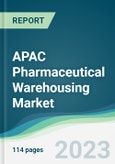The APAC pharmaceutical warehousing market is evaluated at US$ 17.384 billion for the year 2021 and is projected to grow at a CAGR of 19.81% to reach the market size of US$ 61.592 billion by the year 2028.
APAC pharmaceutical warehousing, a pivotal component of the pharmaceutical supply chain, involves the storage and distribution of pharmaceutical products across the Asia Pacific region. The intricacies of a pharmaceutical company's distribution network hinge on factors like the location of manufacturing sites and the specific handling requirements of diverse products. Additionally, the ever-evolving landscape of market demands and competition plays a crucial role in shaping a company's inventory management and formulating effective go-to-market strategies. The Asia Pacific region has emerged as a global leader in the pharmaceutical industry, driving the worldwide market forward.According to the blog published by the National Investment Promotion & Facilitation Agency, The Indian pharmaceutical industry is projected to reach $65 billion by 2024 and $130 billion by 2030. Currently valued at $50 billion, India stands as a major exporter of pharmaceuticals, supplying over 200 countries worldwide. With over 50% of Africa's generic drug requirements, 40% of generic demand in the US, and 25% of all medicines in the UK sourced from India, the country plays a pivotal role in ensuring global access to affordable medications.
Demographic landscape of Asia
The demographic landscape of Asia is currently undergoing a profound transformation, marked by a dual phenomenon of population growth and decline. The major economic powerhouses of the region, including China, Japan, South Korea, and Taiwan, are grappling with the challenges posed by rapidly aging populations. In stark contrast, other nations such as India, Indonesia, the Philippines, and Vietnam are experiencing sustained population growth. This demographic dichotomy is not only shaping the internal dynamics of these countries but is also forging new connections and presenting novel challenges across the continent.The demographic landscape of several Asian countries, including South Korea, Taiwan, and China, is poised for significant transformations, primarily driven by current fertility rates. Projections indicate that South Korea is on track to experience a substantial decline of almost 35 percent in its working-age population, defined as individuals aged 20 to 64, by the year 2050. Similarly, Taiwan and China are also anticipated to undergo notable reductions of 28.6 percent and 20.6 percent, respectively, in their working-age populations over the same period. For China, this equates to a staggering decline of more than 186 million individuals within this crucial age bracket over the next 27 years. These demographic shifts carry profound implications for labor markets, economic dynamics, and social structures, as a shrinking working-age population may pose challenges related to workforce availability, economic productivity, and support systems for the elderly. Policymakers and stakeholders in these regions will need to proactively address and adapt to these demographic trends to ensure sustainable economic and social development in the coming decades.
The China pharmaceutical warehousing market is anticipated to grow steadily.
The pharmaceutical warehousing sector in China is seeing rapid growth as a result of increased healthcare spending and the industry's rapid expansion. With the development of cutting-edge technology like RFID and temperature monitoring systems, together with tight regulatory compliance, the need for effective and secure storage solutions is growing. Government initiatives, the growth of e-commerce, and the integration of global supply chains are all further shaping the environment. Moreover, there is a growing demand for specialist cold chain logistics to maintain the integrity of temperature-sensitive drugs. These related components demonstrate the dynamic and evolving nature of China's pharmaceutical warehousing industry.China's pharmaceutical business has been expanding steadily, and by the end of 2023, it is predicted to reach $161.8 billion, accounting for around 30% of the worldwide market. In addition, most market sales have been dominated by foreign MNC pharmaceutical businesses, including those from the U.S., and top Chinese pharmaceutical companies. However, a lot of SMEs find the National Reimbursement Drug List (NRDL) listing and the National Medical Products Administration (NMPA) registration to be too expensive.
In October 2023, the Office of Foreign Assets Control (OFAC) of the U.S. Department of the Treasury designated 28 individuals and entities that are involved in the global spread of illicit drugs. This network includes a Chinese-based organization that produces and distributes large amounts of methamphetamine, fentanyl, and MDMA precursors. The people that OFAC has named are also involved in the global trafficking of extraordinarily strong substances called "nitazenes," or xylazine, which are frequently combined with other narcotics like fentanyl.
Market Key Developments
- In June 2023, Akums announced its central warehousing pilot project located in the SIDCUL Industrial Estate, Haridwar.
- In January 2021, JD constructed a specialized warehouse in Shenyang, Liaoning province, in response to the industry's growing need for pharmaceutical product shipping. The 10,000-square-meter warehouse offers third-party logistics, or 3PL, outsourced operational logistics services for medical equipment and supplies. For different medicine requirements, it has many temperature storage settings, including cold, room temperature, refrigerated, and frozen.
Segmentation:
By Type of Service
- Cold-Chain Warehouse
- Non-cold Chain Warehouse
By Country
- China
- India
- Japan
- South Korea
- Indonesia
- Taiwan
- Thailand
- Others
Table of Contents
1. INTRODUCTION6. WORLD BANK AND UNITED NATIONS OUTLOOK FOR APAC HEALTHCARE INDUSTRY
2. REGION OUTLOOK
3. APAC HEALTHCARE OUTLOOK
4. INVESTMENT ANALYSIS
5. STOCK MOVEMENT OF KEY PLAYERS
7. APAC PHARMACEUTICAL WAREHOUSING MARKET OUTLOOK
8. APAC PHARMACEUTICAL WAREHOUSING MARKET OUTLOOK
Companies Mentioned
- Kintetsu World Express (Kintetsu Group Holdings)
- DHL (DHL Group)
- Kerry Logistics (SF Express)
- Nippon Express
- CEVA Logistics (SF Express)
Methodology

LOADING...
Table Information
| Report Attribute | Details |
|---|---|
| No. of Pages | 114 |
| Published | December 2023 |
| Forecast Period | 2021 - 2028 |
| Estimated Market Value ( USD | $ 17.38 Billion |
| Forecasted Market Value ( USD | $ 61.59 Billion |
| Compound Annual Growth Rate | 19.8% |
| Regions Covered | Asia Pacific |
| No. of Companies Mentioned | 5 |








